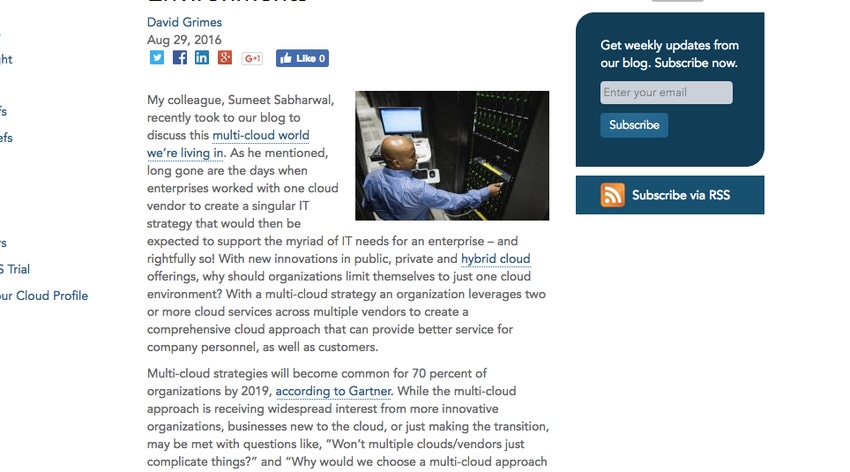Long gone are the days when enterprises worked with one cloud vendor to create a singular IT strategy that would then be expected to support the myriad IT needs for an enterprise. With new innovations in public, private and hybrid cloud offerings, why should organizations limit themselves to just one cloud environment?
October 10, 2016

Sponsored Content
 My colleague Sumeet Sabharwal recently wrote a blog discussing this multi-cloud world we’re living in. As he mentioned, long gone are the days when enterprises worked with one cloud vendor to create a singular IT strategy that would then be expected to support the myriad IT needs for an enterprise–and rightfully so! With new innovations in public, private and hybrid cloud offerings, why should organizations limit themselves to just one cloud environment? With a multi-cloud strategy, an organization leverages two or more cloud services across multiple vendors to create a comprehensive cloud approach that can provide better service for company personnel, as well as customers.
My colleague Sumeet Sabharwal recently wrote a blog discussing this multi-cloud world we’re living in. As he mentioned, long gone are the days when enterprises worked with one cloud vendor to create a singular IT strategy that would then be expected to support the myriad IT needs for an enterprise–and rightfully so! With new innovations in public, private and hybrid cloud offerings, why should organizations limit themselves to just one cloud environment? With a multi-cloud strategy, an organization leverages two or more cloud services across multiple vendors to create a comprehensive cloud approach that can provide better service for company personnel, as well as customers.
Multi-cloud strategies will become common for 70 percent of organizations by 2019, according to Gartner. While the multi-cloud approach is receiving widespread interest from more innovative organizations, businesses new to the cloud, or just making the transition, may be met with questions like, “Won’t multiple clouds/vendors just complicate things?” and “Why would we choose a multi-cloud approach over a single cloud model?” These are valid questions and–particularly with regard to management–there are certainly some unique considerations. With that said, the benefits of multi-cloud are plentiful.
There are a number of arguments for the multi-cloud approach that should be highlighted when stating the case for business, including:
Greater choice: Just as in life, choice is key in business decision making. Leveraging multiple cloud providers and cloud platforms enables enterprises to support a diverse application portfolio at an optimal level. Enterprise IT teams are tasked with running an ever-changing assortment of workloads and require flexibility in selecting the right platform to service each; one size most definitely does not fit all.
Enhanced customization: With the widespread increase in cloud deployments comes an inherent layer of sophistication and complexity in building a sound IT environment. A “cookie cutter” cloud simply won’t work. Today’s organizations want to architect the best environments to manage their specific applications, and that means matching specific applications with tailored cloud solutions. Through a multi-cloud model, organizations can cherry pick solutions to best support the diverse elements of their IT ecosystem.
Reduced latency/optimal service: Enterprises using multiple providers often seek this approach to combat latency issues. This can be especially true for geographically dispersed organizations that need support across different regions with different data jurisdictions. By spreading out your IT environment you create an “insurance policy” that if one application goes down, the whole system does not necessarily need to go down with it. With a more reliable IT environment, organization can provide optimal availability and uptime to customers.
Reduced cost: With older cloud implementations, organizations were often forced to pay for more than they needed. The multi-cloud model enables businesses to reduce costs by allowing them to select and pay only for services and support that they truly need to maintain their business.
With all of these benefits, the multi-cloud approach is easily becoming one of the biggest trends in cloud deployments. As I mentioned, however, managing multiple IT vendors and systems can be complicated if not done properly. Choosing a managed cloud provider can help alleviate some of these challenges by outsourcing routine infrastructure management and maintenance burdens, and enabling internal IT teams to focus on strategic initiatives and overall customer satisfaction.
This is an exciting time for the enterprise as the world of cloud is becoming more open every day to enable more flexible, customized, reliable and cost-effective technology implementations. Now it is the responsibility of cloud providers to ensure these options can work together seamlessly.
 David Grimes is Chief Technology Officer, NaviSite.
David Grimes is Chief Technology Officer, NaviSite.
Guest blogs such as this one are published monthly and are part of MSPmentor’s annual platinum sponsorship.
You May Also Like
